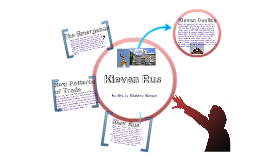Russian PowerPoint
Transcript: Cyrillic - Slavic alphabet. Named after the Slavicenlightener Cyril, who, along with his brother created the first Slavic alphabet of 38 letters The Emergence Russia shared many features with the rest of northern europe before the 15th century. Slavic people had moved into the sweeping plains of Russia, and eastern europe. they mixed with and incorporated some earlier inhabitants and some additional invaders, such as the bulgarians. Slavs had a rich traditon of folk music and oral legends and developed some very loose regional kingdoms An Era in Eastern Europe Rus' Facts: During the 6th and 7th centuries traders from scandinavia began to work through slavic lands. Scandinavian traders (superior to slavs) gradually set up new governments along their trade routes specifically in the city of kiev. A monarchy emerged under a man named Rurik, named Kievan Rus' about 855 c.e. Cited work: Stearns, Peter, Micheal Adas, Stuart b. Schwartz, and Marc Gilbert. Rus Kievan. 6th. 6. Columbus: Pearson, 2001. 903. "§ 9. Culture of Kievan Rus." Украинские учебники. Web. 19 Dec. 2011. <http://ukrmap.su/en-uh7/976.html> "History of Russia from Early Slavs History and Kievan Rus to Romanovs Dynasty." Parallel 60 - Russian Travel Agency, Tours to Saint-Petersburg, Moscow, Lake Baikal. Web. 19 Dec. 2011. <http://www.parallelsixty.com/history-russia.shtml>. "Vladimir I of Kiev - New World Encyclopedia." Info:Main Page - New World Encyclopedia. Web. 19 Dec. 2011. <http://www.newworldencyclopedia.org/entry/Vladimir_I_of_Kiev>. ХРОНОС. ВСЕМИРНАЯ ИСТОРИЯ В ИНТЕРНЕТЕ. Web. 20 Dec. 2011. <http://www.hrono.info>. "Yaroslav the Wise – Russiapedia History and Mythology Prominent Russians." Get Russianalized – Russiapedia. Web. 20 Dec. 2011. <http://russiapedia.rt.com/prominent-russians/history-and-mythology/yaroslav-the-wise/> Kievan Rus borrowed much from Byzantium. Major princes were attracted to Byzantine ceremonies and luxury. Characteristics of orthadox christianity increased monastic movement developed and stress prayer and charity. Russian literature that developed used the cyrillic alphabet. Russian (and Ukrainian) art focused on religious aspects with icon paintings. Russia had an aristocratic landlord class (aristocrats called boyars). Yaroslav the Wise was the Grand Prince of Kiev since 1016 until his death in 1054 (with break in 1018-1019). As many historians believe, under Yaroslav Kievan Russia reached a peak of its cultural bloom and military power Kiev Rus' Rurik, ruler of Novgorod Oleg, first ruler of Kiev, 882-913 Igor, 913-945 Svyatoslav I, 945-973 Yaropolk I, 973-978 St. Vladimir I, 978-1015 Svyatopolk I, 1015-1019 Yaroslav "the Wise," 1019-1054 Izayaslav I, 1054-1073 Svyatoslav II, 1073-1076 Izayaslav I, 1077-1078 Vsevolod, 1078-1093 Svyatopolk II, 1093-1113 Vladimir Monomakh, 1113-1125 Mstislav I, 1125-1139 Yaropolk II, 1132-1139 Vyacheslav, 1139-1146 Izayaslav II, 1146-1154 Yury Dolgoruky, 1149-1157 Rostislav, 1154-1167 Andrei Bogolyubsky, Grand Prince of Kiev, 1157-1174 Vsevolod III, ruler of Vladimir-Suzdal, 1176-1212 Yury II, 1212-1238 Kievan Decline Rus' Facts: New Patterns of Trade Rulers: Vladimir Svyatoslavich the Great (c. 958 – July 15, 1015, Berestovo), also known as Saint Vladimir of Kiev, was the grand prince of Kiev who converted to Christianity in 988 and is generally credited as the person most responsible for the Christianization of Russia. Kievan Rus Kievan Rus posessed rival princes who set up regional gov't trying to over throw the throne. The final blow in the first chapter of Russian history came in 1237-1238 and 1240-1241 when two invasions by mongols moved through Russia. Called tatars in Russian tradition, the invaders were quickly dispised. For over two centries Russia remained under tatar control. This control further seperated Russian history from that of western Europe. However, Tatar control was finally forced out in the second half of the fifteenth centry. Rus' Facts: Yaroslav I the Wise (c. 978 - February 20, 1054) (East Slavic: Ярослав Мудрый; Christian name: George; Old Norse: Jarizleifr) was thrice Grand Prince of Novgorod and Kiev, uniting the two principalities for a time under his rule. During his lengthy reign, Kievan Rus' reached a zenith of its cultural flowering and military power. He codified the law and, through marriage alliances, positioned Kiev strategically within a network of powerful states establishing conditions that resulted in almost two centuries of peace and prosperity for his people. Civil war, though, disrupted this after his death as his heirs disputed the succession. He consolidated ties with the Byzantine Church, asking the Patriarch of Constantinople to appoint a Metropolitan for whom he build a Cathedral.

















